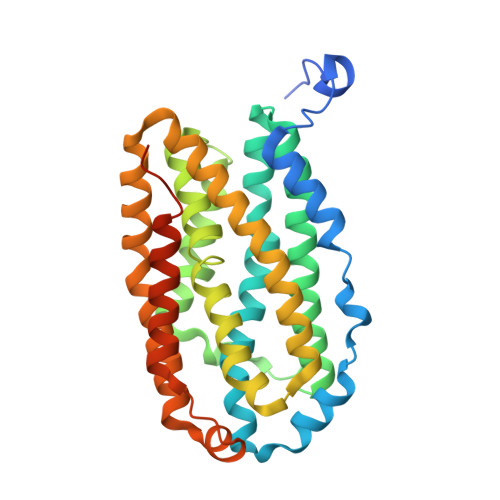Chemical flexibility of heterobimetallic Mn/Fe cofactors: R2lox and R2c proteins.
Kutin, Y., Kositzki, R., Branca, R.M.M., Srinivas, V., Lundin, D., Haumann, M., Hogbom, M., Cox, N., Griese, J.J.(2019) J Biol Chem 294: 18372-18386
- PubMed: 31591267
- DOI: https://doi.org/10.1074/jbc.RA119.010570
- Primary Citation of Related Structures:
6I90, 6I92, 6I93, 6I94, 6I95 - PubMed Abstract:
A heterobimetallic Mn/Fe cofactor is present in the R2 subunit of class Ic ribonucleotide reductases (R2c) and in R2-like ligand-binding oxidases (R2lox). Although the protein-derived metal ligands are the same in both groups of proteins, the connectivity of the two metal ions and the chemistry each cofactor performs are different: in R2c, a one-electron oxidant, the Mn/Fe dimer is linked by two oxygen bridges (μ-oxo/μ-hydroxo), whereas in R2lox, a two-electron oxidant, it is linked by a single oxygen bridge (μ-hydroxo) and a fatty acid ligand. Here, we identified a second coordination sphere residue that directs the divergent reactivity of the protein scaffold. We found that the residue that directly precedes the N-terminal carboxylate metal ligand is conserved as a glycine within the R2lox group but not in R2c. Substitution of the glycine with leucine converted the resting-state R2lox cofactor to an R2c-like cofactor, a μ-oxo/μ-hydroxo-bridged Mn III /Fe III dimer. This species has recently been observed as an intermediate of the oxygen activation reaction in WT R2lox, indicating that it is physiologically relevant. Cofactor maturation in R2c and R2lox therefore follows the same pathway, with structural and functional divergence of the two cofactor forms following oxygen activation. We also show that the leucine-substituted variant no longer functions as a two-electron oxidant. Our results reveal that the residue preceding the N-terminal metal ligand directs the cofactor's reactivity toward one- or two-electron redox chemistry, presumably by setting the protonation state of the bridging oxygens and thereby perturbing the redox potential of the Mn ion.
Organizational Affiliation:
Max Planck Institute for Chemical Energy Conversion, Stiftstrasse 34-36, D-45470 Mülheim an der Ruhr, Germany.
















